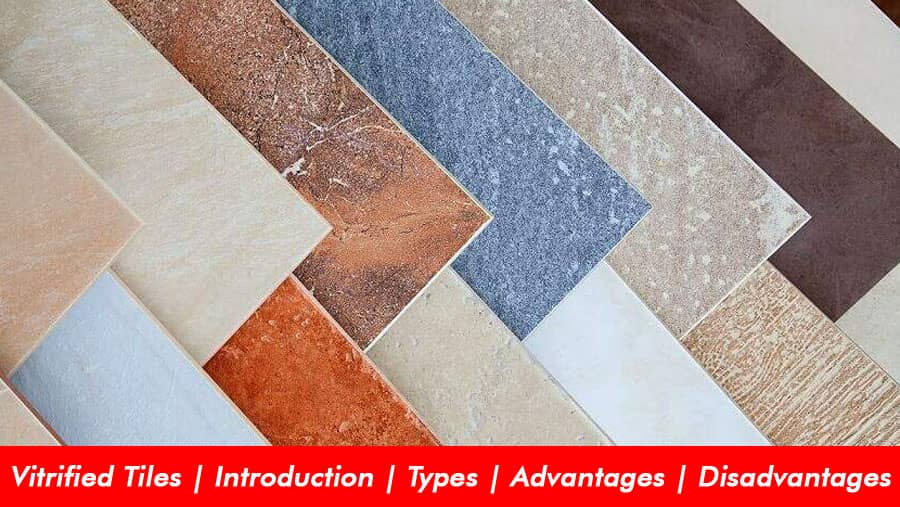Vitrified Tiles | Introduction | Types | Advantages | Disadvantages

In today's fast-paced world, when it comes to flooring and wall coverings, there's a wide variety of options to choose from. One such option gaining popularity in recent times is vitrified tiles. These tiles are known for their durability, versatility, and aesthetic appeal.
Understanding Vitrified Tiles
Vitrified tiles are a type of ceramic tile that undergoes a unique manufacturing process, resulting in a tile that is highly durable and resistant to wear and tear. The term "vitrified" refers to the process of making the tiles extremely dense and non-porous by baking them at high temperatures. This process ensures that vitrified tiles are not only sturdy but also water-resistant, making them suitable for a wide range of applications.
Types of Vitrified Tiles
There are several types of vitrified tiles available in the market, each with its own set of characteristics. The most common types include:
- Glazed Vitrified Tiles (GVT): Glazed vitrified tiles are known for their vibrant colors and glossy finish. They are often used for interior applications and are an excellent choice for adding a touch of elegance to your living spaces.
- Full Body Vitrified Tiles (FBVT): Full body vitrified tiles are solid throughout, which means the color and texture run uniformly from the surface to the core. This type of tile is highly durable and is ideal for high-traffic areas.
- Double Charged Vitrified Tiles (DCVT): Double charged vitrified tiles are known for their unique patterns and designs. These tiles are created by infusing two different colors of clay into the tile body, resulting in striking visuals. They are often used for creating visually appealing floors.
Advantages of Vitrified Tiles
Now, let's explore some of the compelling advantages of using vitrified tiles in your home or commercial space.
- Durability and Longevity: Vitrified tiles are incredibly durable and can withstand heavy foot traffic without showing signs of wear and tear. They have a longer lifespan compared to many other flooring options, making them a cost-effective choice in the long run.
- Aesthetic Appeal: With a wide range of designs, colors, and patterns available, vitrified tiles offer endless possibilities when it comes to enhancing the visual appeal of your space. Whether you prefer a classic or contemporary look, there's a vitrified tile design to suit your taste.
- Low Maintenance: Maintenance is a breeze with vitrified tiles. They are easy to clean and require minimal effort to keep them looking as good as new. Regular sweeping and occasional mopping are usually sufficient to maintain their shine.
- Resistance to Stains and Scratches: Vitrified tiles are highly resistant to stains, scratches, and chemical damage. This makes them an excellent choice for areas prone to spills and accidents, such as kitchens and bathrooms.
- Versatility in Design: Whether you want a sleek, modern appearance or a more rustic and traditional look, vitrified tiles can accommodate your design preferences. They are available in various sizes and finishes, allowing you to customize your space.
Disadvantages of Vitrified Tiles
While vitrified tiles offer numerous advantages, it's essential to consider their drawbacks as well.
- Cost: Compared to some other flooring options, vitrified tiles can be relatively expensive. However, their durability and low maintenance costs offset this initial investment.
- Installation Complexity: Installing vitrified tiles can be more complex than other types of flooring. It's crucial to hire a professional installer to ensure a seamless finish.
- Cold Surface: Vitrified tiles can feel cold to the touch, which may not be comfortable in colder climates. Using rugs or underfloor heating systems can mitigate this issue.
- Slippery When Wet: The glossy surface of glazed vitrified tiles can become slippery when wet, posing a slip hazard. It's advisable to use anti-slip coatings in areas prone to moisture.
Conclusion
In conclusion, vitrified tiles are an excellent choice for flooring and wall coverings, offering durability, aesthetic appeal, and low maintenance. While they may have some disadvantages, their numerous advantages make them a popular option for both residential and commercial spaces.
FAQs
Are vitrified tiles suitable for outdoor use?
Vitrified tiles are primarily designed for indoor use. For outdoor applications, it's recommended to use outdoor-rated tiles.
Can I install vitrified tiles myself?
While it's possible to install vitrified tiles yourself, it's best to hire a professional to ensure a flawless finish.
Are vitrified tiles eco-friendly?
Vitrified tiles are made from natural materials and are considered eco-friendly compared to some other flooring options.
How do I clean and maintain vitrified tiles?
Regular sweeping and mopping with a mild detergent solution are usually sufficient for cleaning vitrified tiles.
Are vitrified tiles a good choice for a bathroom?
Yes, vitrified tiles are an excellent choice for bathrooms due to their resistance to water and stains.
